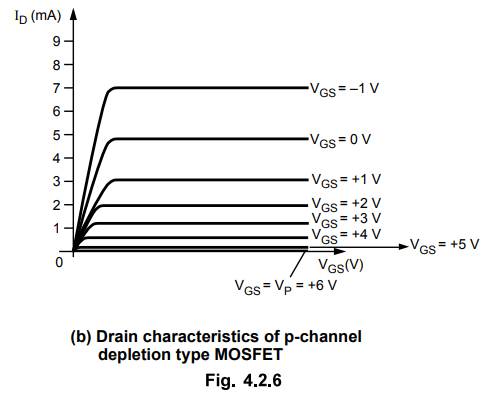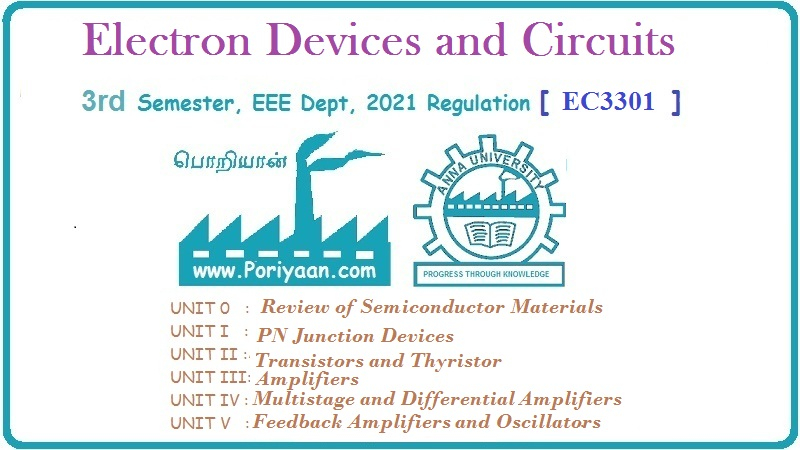Electron Devices and Circuits: Unit II: (c) MOSFET
Depletion MOSFET (D-MOSFET)
Construction, Operation, Symbols, Characteristics, Parameters
1. Construction of n-Channel MOSFET 2. Operation, Characteristics and Parameters of n-Channel MOSFET 3. p-Channel Depletion Type MOSFET 4. D-MOSFET Symbols
Depletion MOSFET (D-MOSFET)
AU
: Dec.-17, 18
1. Construction of n-Channel MOSFET
•
The Fig. 4.2.1 shows the basic n-channel depletion type MOSFET.

•
Two highly doped n-regions are diffused into a lightly doped p-type substrate.
•
These two highly doped n-regions represent source and drain. Usually substrate
is internally connected to the source terminal.
•
The source and drain terminals are connected through metallic contacts to
n-doped regions linked by an n-channel as shown in the Fig. 4.2.1. The length
of the channel is denoted by L.
•
The gate is also connected to a metal contact surface but remains insulated
from the n-channel by a very thin layer of dielectric material, silicon dioxide
(SiO2)
•
Thus, there is no direct electrical connection between the gate terminal and
the channel of a MOSFET, increasing the input impedance of the device.
2. Operation, Characteristics and Parameters of n-Channel MOSFET
•
On the application of drain to source voltage, VDS and keeping gate to source
voltage to zero by directly connecting gate terminal to the source terminal,
free electrons from the n-channel are attracted towards positive potential of
drain terminal.
•
This establishes current through the channel to be denoted as IDSS
at VGS = 0 V, as shown in the Fig. 4.2.2.

•
If we apply negative gate voltage, the negative charges on the gate repel
conduction electrons from the channel, and attract holes from the p-type
substrate.
•
This initiates recombination of repelled electrons and attracted holes as shown
in the Fig. 4.2.3.

•
The level of recombination between electrons and holes depends on the magnitude
of the negative voltage applied at the gate.
•
This recombination reduces the number of free electrons in the n-channel for
the conduction, reducing the drain current.
•
In other words we can say that, due to recombinations, n-channel is depleted of
some of its electrons, thus decreasing the channel conductivity.
•
The greater the negative voltage applied at the gate, the greater the depletion
of n-channel electrons.
•
The level of drain current will reduce with increasing negative bias for VGS as
shown in the transfer characteristics of depletion type MOSFET (Fig- 4.2.4).

•
For positive values of VGS the positive gate will draw additional electrons
from the p-type substrate due to reverse leakage current and establish new
carriers through the collisions between accelerating particles. Because of
this, as gate to source voltage increases in positive direction, the drain current
also increases as shown in the Fig. 4.2.4.
•
The application of a positive gate to source voltage has "enhanced"
the level of free carriers in the channel compared to that encountered with VGS
= 0 V. For this reason the region of positive gate voltages on the drain or
transfer characteristics is referred to as enhancement region and the region
between cut-off and the saturation levels of IDSS referred to as depletion
region.
•
Fig. 4.2.5 shows drain characteristics for an n-channel depletion type MOSFET.
It is similar to that of JFET. The only difference is that it has positive part
of VGS'

•
It is defined as the ratio of change in drain current to the corresponding
change in gate to source voltage, at a constant of drain to source voltage
gm
= Δ ID / Δ VGS | constant VDS
Important
Concept
ID
= 0 corresponds to VGS (off) ,V GS (off) = - Vp
2.
VGS = 0 corresponds to IDSS.
3.
Both positive and negative values of VGS can be used to bias
D-MOSFET.
3. p-Channel Depletion Type MOSFET
•
The construction of the p-channel depletion type MOSFET is exactly opposite of
that of n-channel depletion type MOSFET.
•
Here, the substrate is of n-type, and regions and channels are of p-type as
shown in the Fig. 4.2.6 (a).

•
As shown in the Fig. 4.2.6 (a) voltage polarities and current directions are
reversed.
•
The drain characteristics appear exactly as in Fig. 4.2.6 (b) but VDS with
negative values, ID in the opposite direction and VGS having opposite
polarities as shown in the Fig. 4.2.6 (b).

•
Fig. 4.2.6 (c) shows the transfer characteristics of p-channel depletion type
MOSFET.

•
In the p-channel depletion type MOSFET, the transfer characteristics is a
mirror image about the ID axis (Y axis) of the transfer characteristic of
n-channel depletion type MOSFET, since the VGS is positive in p-channel
depletion region.
4. D-MOSFET Symbols
•
Fig. 4.2.7 shows graphic symbols for a n and p-channel depletion type MOSFET.

Review Questions
1. Explain the construction, operation and characteristics of
n-channel depletion type MOSFET.
2. Define transconductance.
3. Define transconductance of MOSFET. AU : Dec.-17, Marks 2
4. Explain the working of a depletion mode MOSFET. Draw and explain
its VI characteristics.
5. Explain the working of a n-channel depletion MOSFET. Discuss
its transfer characteristics.
Electron Devices and Circuits: Unit II: (c) MOSFET : Tag: : Construction, Operation, Symbols, Characteristics, Parameters - Depletion MOSFET (D-MOSFET)
Related Topics
Related Subjects
Electron Devices and Circuits
EC3301 3rd Semester EEE Dept | 2021 Regulation | 3rd Semester EEE Dept 2021 Regulation
